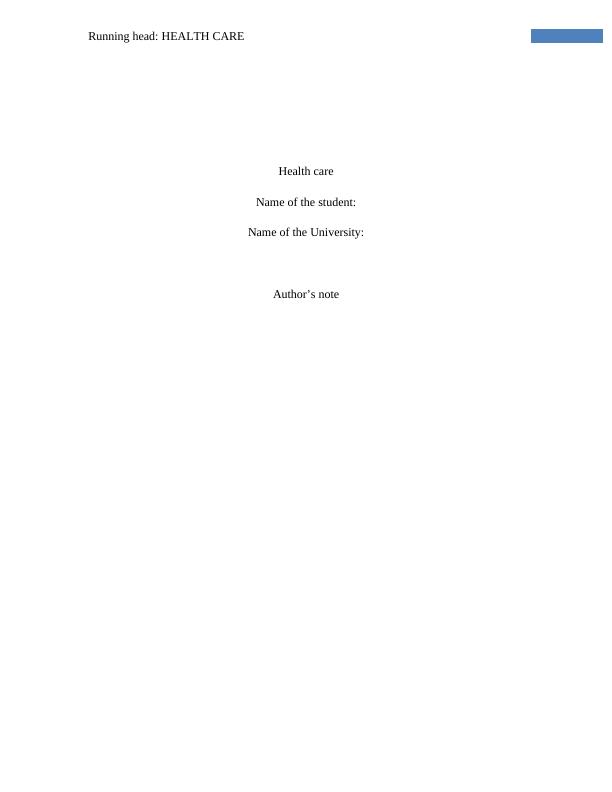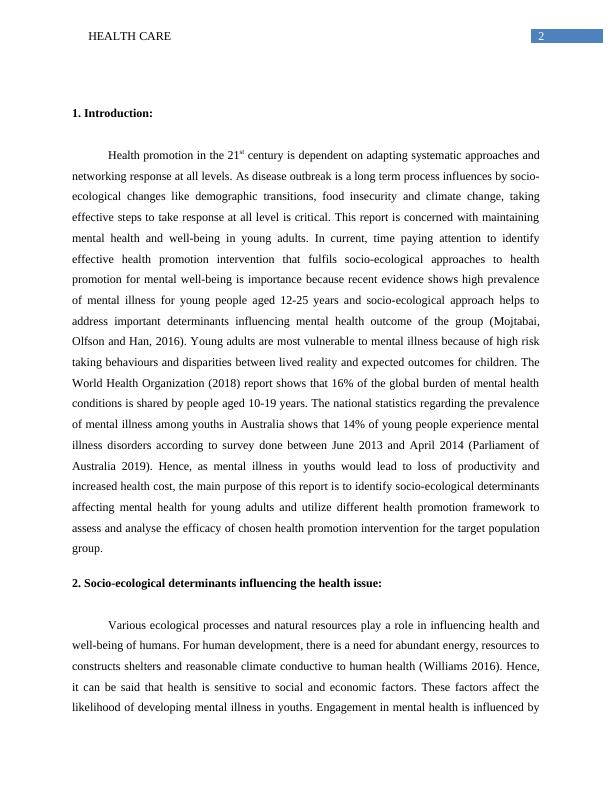Health Care
Added on 2023-03-31
14 Pages3371 Words171 Views
Running head: HEALTH CARE
Health care
Name of the student:
Name of the University:
Author’s note
Health care
Name of the student:
Name of the University:
Author’s note

1HEALTH CARE
Table of Contents
1. Introduction:................................................................................................................................2
2. Socio-ecological determinants influencing the health issue:.......................................................3
3. Assessment of efficacy of the intervention:.................................................................................4
3.1 Evaluation of the intervention against heath promotion framework:....................................5
3.2 Suitability of the intervention according to the 3 principles areas of action:........................6
3.3 Congruency with two of the five determinants of health:.....................................................7
3.4 Evaluation of system thinking approach................................................................................8
3.5 Suitability of the intervention in promoting health equity or environmental sustainability:.8
4. Conclusion:..................................................................................................................................9
Table of Contents
1. Introduction:................................................................................................................................2
2. Socio-ecological determinants influencing the health issue:.......................................................3
3. Assessment of efficacy of the intervention:.................................................................................4
3.1 Evaluation of the intervention against heath promotion framework:....................................5
3.2 Suitability of the intervention according to the 3 principles areas of action:........................6
3.3 Congruency with two of the five determinants of health:.....................................................7
3.4 Evaluation of system thinking approach................................................................................8
3.5 Suitability of the intervention in promoting health equity or environmental sustainability:.8
4. Conclusion:..................................................................................................................................9

2HEALTH CARE
1. Introduction:
Health promotion in the 21st century is dependent on adapting systematic approaches and
networking response at all levels. As disease outbreak is a long term process influences by socio-
ecological changes like demographic transitions, food insecurity and climate change, taking
effective steps to take response at all level is critical. This report is concerned with maintaining
mental health and well-being in young adults. In current, time paying attention to identify
effective health promotion intervention that fulfils socio-ecological approaches to health
promotion for mental well-being is importance because recent evidence shows high prevalence
of mental illness for young people aged 12-25 years and socio-ecological approach helps to
address important determinants influencing mental health outcome of the group (Mojtabai,
Olfson and Han, 2016). Young adults are most vulnerable to mental illness because of high risk
taking behaviours and disparities between lived reality and expected outcomes for children. The
World Health Organization (2018) report shows that 16% of the global burden of mental health
conditions is shared by people aged 10-19 years. The national statistics regarding the prevalence
of mental illness among youths in Australia shows that 14% of young people experience mental
illness disorders according to survey done between June 2013 and April 2014 (Parliament of
Australia 2019). Hence, as mental illness in youths would lead to loss of productivity and
increased health cost, the main purpose of this report is to identify socio-ecological determinants
affecting mental health for young adults and utilize different health promotion framework to
assess and analyse the efficacy of chosen health promotion intervention for the target population
group.
2. Socio-ecological determinants influencing the health issue:
Various ecological processes and natural resources play a role in influencing health and
well-being of humans. For human development, there is a need for abundant energy, resources to
constructs shelters and reasonable climate conductive to human health (Williams 2016). Hence,
it can be said that health is sensitive to social and economic factors. These factors affect the
likelihood of developing mental illness in youths. Engagement in mental health is influenced by
1. Introduction:
Health promotion in the 21st century is dependent on adapting systematic approaches and
networking response at all levels. As disease outbreak is a long term process influences by socio-
ecological changes like demographic transitions, food insecurity and climate change, taking
effective steps to take response at all level is critical. This report is concerned with maintaining
mental health and well-being in young adults. In current, time paying attention to identify
effective health promotion intervention that fulfils socio-ecological approaches to health
promotion for mental well-being is importance because recent evidence shows high prevalence
of mental illness for young people aged 12-25 years and socio-ecological approach helps to
address important determinants influencing mental health outcome of the group (Mojtabai,
Olfson and Han, 2016). Young adults are most vulnerable to mental illness because of high risk
taking behaviours and disparities between lived reality and expected outcomes for children. The
World Health Organization (2018) report shows that 16% of the global burden of mental health
conditions is shared by people aged 10-19 years. The national statistics regarding the prevalence
of mental illness among youths in Australia shows that 14% of young people experience mental
illness disorders according to survey done between June 2013 and April 2014 (Parliament of
Australia 2019). Hence, as mental illness in youths would lead to loss of productivity and
increased health cost, the main purpose of this report is to identify socio-ecological determinants
affecting mental health for young adults and utilize different health promotion framework to
assess and analyse the efficacy of chosen health promotion intervention for the target population
group.
2. Socio-ecological determinants influencing the health issue:
Various ecological processes and natural resources play a role in influencing health and
well-being of humans. For human development, there is a need for abundant energy, resources to
constructs shelters and reasonable climate conductive to human health (Williams 2016). Hence,
it can be said that health is sensitive to social and economic factors. These factors affect the
likelihood of developing mental illness in youths. Engagement in mental health is influenced by

3HEALTH CARE
factors like social, physical and policy environments. According to the ecological model,
individual comes at the centre of the model. The individual factors that may contribute to mental
illness in youths include age, gender, money and personal factors. Early life events like parental
separation and child abuse and violence create risk of exposure to prolonged to stress for people
and increased duration of stress is strongly linked with the increase in risk of developing
psychiatric disorders (Schiavone, Colaianna & Curtis, 2015). Hence, review of early life events
in youth can be important predictors of factors influencing mental illness. In addition, low
education, unemployment and poor housing contributed to mental disorders. Education
profoundly influences adult socioeconomic status and access to resource for good life. Hence,
educational attainment is a strong predictor of employment, access to quality life and the
likelihood of experiencing mental health problems (Brännlund, Strandh and Nilsson 2017).
The social environment of an individual is strongly linked with development of mental
health problems. Social environment includes exposure to appropriate relationship, culture and
society. Mental health of youth is influenced by factors like peer group, overcrowding and social
support. Peers and family have a significant role in promoting health of young children.
Relationship with peers plays a role in children’s development and getting opportunities for
being acquainted with social norms and self-control. However, negative peer influence such as
peer rejection and peer harassment contribute to later life maladjustment and risk of mental
illness. In addition, social support has been determined as a determinant for mental illness by
WHO and different types of access to social networks and social support predicts development of
mental illness and psychiatric symptoms (Smyth et al. 2015). In addition, physical environments
like access to health care facilities, cultural aspects and community environments are the
determinants influencing rate and type of mental health problems. Satcher, Okafor and Dill
(2012) defines that build environment of people such as access to mental health service, public
transportation, availability of recreational source and peaceful or violent environment are some
determinants of health. Unequal distribution of these resources in youth contributes to hardship,
deprivation and risk factors of mental illness. Furthermore, policy related action such as
implementation of appropriate urban planning policies, active transport policies, health policies,
workplace policies has indirect effect on mental health problems. Therefore, this discussion
shows how chain of social and ecological factors interconnects with each other to influence
mental health.
factors like social, physical and policy environments. According to the ecological model,
individual comes at the centre of the model. The individual factors that may contribute to mental
illness in youths include age, gender, money and personal factors. Early life events like parental
separation and child abuse and violence create risk of exposure to prolonged to stress for people
and increased duration of stress is strongly linked with the increase in risk of developing
psychiatric disorders (Schiavone, Colaianna & Curtis, 2015). Hence, review of early life events
in youth can be important predictors of factors influencing mental illness. In addition, low
education, unemployment and poor housing contributed to mental disorders. Education
profoundly influences adult socioeconomic status and access to resource for good life. Hence,
educational attainment is a strong predictor of employment, access to quality life and the
likelihood of experiencing mental health problems (Brännlund, Strandh and Nilsson 2017).
The social environment of an individual is strongly linked with development of mental
health problems. Social environment includes exposure to appropriate relationship, culture and
society. Mental health of youth is influenced by factors like peer group, overcrowding and social
support. Peers and family have a significant role in promoting health of young children.
Relationship with peers plays a role in children’s development and getting opportunities for
being acquainted with social norms and self-control. However, negative peer influence such as
peer rejection and peer harassment contribute to later life maladjustment and risk of mental
illness. In addition, social support has been determined as a determinant for mental illness by
WHO and different types of access to social networks and social support predicts development of
mental illness and psychiatric symptoms (Smyth et al. 2015). In addition, physical environments
like access to health care facilities, cultural aspects and community environments are the
determinants influencing rate and type of mental health problems. Satcher, Okafor and Dill
(2012) defines that build environment of people such as access to mental health service, public
transportation, availability of recreational source and peaceful or violent environment are some
determinants of health. Unequal distribution of these resources in youth contributes to hardship,
deprivation and risk factors of mental illness. Furthermore, policy related action such as
implementation of appropriate urban planning policies, active transport policies, health policies,
workplace policies has indirect effect on mental health problems. Therefore, this discussion
shows how chain of social and ecological factors interconnects with each other to influence
mental health.

End of preview
Want to access all the pages? Upload your documents or become a member.
Related Documents
Introduction Mental Health Problemslg...
|7
|1390
|37
Public Health Promotion Assignment Reportlg...
|11
|2706
|11
Preventing Depression and Promoting Mental Health in Young Australianslg...
|11
|2439
|188
Prevalence and Prevention of Overweight among Children and Young Adults in the UKlg...
|16
|5886
|73
Public Health Concerns in the UK: Addressing the Leading Cause of Overweight among Children and Young Adultslg...
|10
|4953
|258
Health Promotion: Munch and Move Intervention Among Childrenlg...
|17
|4498
|411
